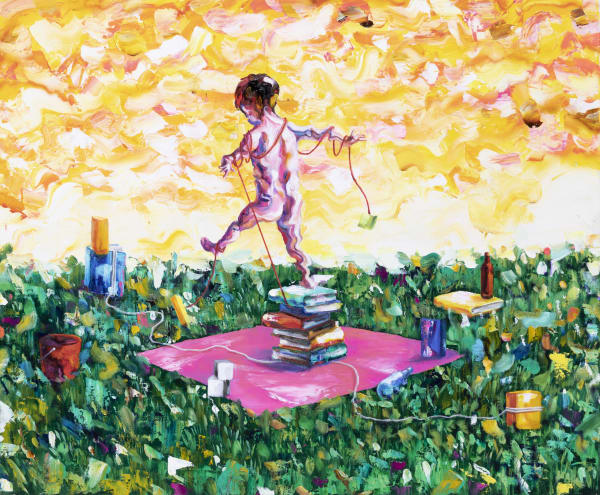Children Playing with Boundaries: 아즈미 나이토 Azumi Naito
Children Playing with Boundaries
아즈미 나이토 (1983) 개인전
April 11 (Fri) – April 30 (Wed), 2025
좌우로 진동하며 흔들리는 배경과 아이. 아즈미 나이토의 작품을 한 마디로 그려내는 문장이다. ‘재현’ 보다 ‘표현’하는 것에 관심을 가진 작가는 처음 판화를 시작하였다. 판화작업을 할 수록 안쪽 세계를 파고드는 느낌을 받은 작가는 우연히 유화작업을 만나 표현의 자유를 경험하게된다.
이후 아즈미 나이토는 아서C클라크의 ‘유년기의 끝’이라는 소설의 내용에 큰 파동을 느끼게 되고, 이어 에드워드 마이브리지의 움직임을 표현하고 있는 아이의 사진에 매료된다. 사진을 통해 움직임의 아름다 움과 동시에 규칙 속에 내재된 무서움을 알아차리게 된 작가는 그 사진으로 부터 느낀 복잡한 감각에 매 료되어 아이를 그리기 시작한다.
<호모루덴스> 아즈미 나이토의 작품의 내용을 관통하는 용어이다. ‘놀이와 개발’이라는 주제로 그림을 그리는 작가는 아이들의 ‘놀이’에서 규범을 획득하고 습득하는 과정 을 발견한다. 이를 통해 작가는 어쩌면 어른들이 느끼는 아이의 자유로움과 달리 아이들은 스스로 법칙 을 요구하고 있는 것이 아닌가에 대한 생각에 이르게 되고 이를 작품으로 풀어나간다.
자유로움으로 대 변되고 있는 불안정성,불확실성 그리고 규범이 없는 것들을 드러내기 위해 작가는 다양한 재료의 사용으 로 유동적인 흐름을 만들어 내며 그 속에서 그만의 법칙을 세워나간다. 도처에 법칙이 있다는 것을 깨달은 나이토는 모든 것이 정해진 법칙에 따라 진화해 나간다는 것에 공포 를 느끼고 그것을 아이라고 하는 이미지를 빌려 자신의 작업 테마를 표현하고있다.
-
Children Playing with Boundaries,
Azumi Naito Solo Exhibition
A child against a background that sways and trembles side to side—this single image captures the essence of Azumi Naito’s work. The artist, who is more interested in “expression” than “representation,” began his artistic journey with printmaking. As he delved deeper into printmaking, he felt as though he was digging into his inner world. Later, by chance, he encountered oil painting and discovered a new sense of freedom in expression.
Azumi Naito was profoundly moved by Arthur C. Clarke’s novel Childhood’s End, and became captivated by a photograph taken by Eadweard Muybridge that depicted the motion of a child. Through this image, he came to recognize not only the beauty of movement, but also the unsettling sense of order and control embedded within it. Fascinated by the complex emotions stirred by the photo, he began to depict children in his work.
Homo Ludens—“the playing human”—is a term that runs through the core of Naito’s artistic practice. Working under the theme of “play and development,” the artist explores how children acquire and internalize rules through play. This led him to the thought that, contrary to the adult perception of children as free-spirited beings, perhaps children themselves seek and demand rules. His works visually explore this idea.
To reveal instability, uncertainty, and the absence of norms—often mistaken for freedom—the artist creates fluid visual flows using a variety of materials, all while establishing his own internal logic within them. Upon realizing that rules exist everywhere, Naito felt a deep fear that everything evolves according to predetermined systems. He now borrows the image of the “child” as a symbolic vessel through which he expresses this existential tension in his work.















